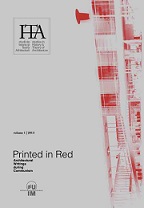When “Words Fall on Deaf Ears”. An Outline of Albania’s Socialist Architecture
When “Words Fall on Deaf Ears”. An Outline of Albania’s Socialist Architecture
Author(s): Dritan MiçoSubject(s): Architecture
Published by: Universitatea de Arhitectură şi Urbanism »Ion Mincu«
Keywords: faster; cheaper; better; socialist architecture; politics; Kolevica
Summary/Abstract: According to the Albanian philosopher and sociologist G. Bobi, the Albanians’ current sense of cultural identity is very well portrayed by Minkowski’s patients’ answers to the question “where are you?” One patient said he was “here”, while another one said “I know where I am, but I do not feel I belong here.” The former points to an extremely burdened identity that expresses provincialism and historicism, while the latter, vaguer, envelops a lack of identification to his place of origin: everywhere and nowhere. Bobi identifies a socio-cultural degradation, caused by multiple factors such as the loss of security, once ensured by the former regime, the dismantlement of the social structure created by that regime for half a century, and the new regime’s inability to offer the benefits it promised (pluralist democracy, welfare, etc.) The social and cultural upheavals following the fall of the regime have particularly baffled the middle class and those faces considered the “pride of the system.” What used to be excommunicated is now glorified, and vice versa. Following its isolation from the rest of the world for several decades during the 20th Century, Albania is one of the most understudied East European nations. Although the socialist era represents a milestone in the modern history of Albania, the “socialist architecture” has never been the subject of an analytical English-language monograph. A range of articles that periodically appeared in various newspapers and magazines have been taken into account; they are the only available sources able to reveal the theoretical framework, if it indeed existed. In addition, the last two decades have grown rich in architects’ memoires, as well as in studies on the subject, conducted by both Eastern and Western scholars.The purpose of this paper is to present the preliminary results of an ongoing research project on the socialist Albanian architecture, in close connection to a blend of cultural, social and economic issues. In spite of the descriptive method used, this study also attempts to bring some initial reflections on, and interpretations of the facts it exposes. Focusing on the architectural and political spheres, the main question is how the Socialist Realism imported from the Soviet Union starting with the late 1940s, was understood and applied in the specific Albanian context; the influences of and relations to the periods prior to, and following socialism are also taken into account.
Journal: sITA – studii de Istoria şi Teoria Arhitecturii
- Issue Year: 2013
- Issue No: 1
- Page Range: 45-59
- Page Count: 15
- Language: English

